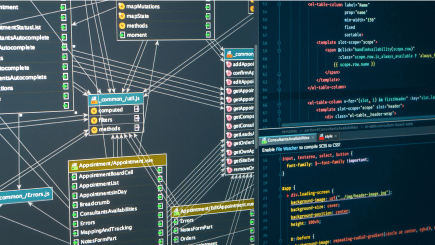
Learn back-end software engineering with online courses
When users interact with software, what they see on screen is the program’s front- end. But, it’s the back- end that powers everything from databases to security. Learn back-end software engineering with online courses delivered through edX.

What is back-end software engineering?
Software development is a subset of engineering that involves the programming of applications and operating systems. If you’ve ever wondered what happens behind the scenes of your computer’s programs, back-end software development is responsible for what you see on your screen.
The back- end is sometimes referred to as a program’s server side. It focuses on everything the user cannot see, including parts of a computer application or system’s code that allow it to operate. Although users don’t directly interact with the back- end of a website, they indirectly interact with elements back-end software engineers work on.
When you log in to your computer, you may be doing so on a device that you share with others. Before accessing the desktop, you may be prompted to enter a username and password. While the screen loads, your operating system’s back- end parses the information you enter, granting or denying your entry. This invisible work is just one example of how back-end software engineering powers the systems we use every day.
Browse online Back-End Software Engineering Certificates
Find new interests and advance your career opportunities
Stand out in your field
Use the knowledge and skills you have gained to drive impact at work and grow your career.
Learn at your own pace
On your computer, tablet or phone, online courses make learning flexible to fit your busy life.
Earn a valuable credential
Showcase your key skills and valuable knowledge.
Certificates
Related Topics
Back-end software engineering course curriculum
A back-end developer course can provide opportunities for hands-on learning. These classes may cover topics such as user authentication and template engines. You may also learn how to program using the MERN stack, which includes the programming tools and libraries MongoDB, Express.js, React.js, and Node.js. These four tools are essential to any back-end development career.
More advanced back-end developer courses might teach how to build and manage databases and servers, implement APIs, and securely store data. You may also learn programming languages, such as Python, PHP, Ruby, and JavaScript. If you’re interested in a course that culminates in a portfolio of work that you can show to employers, look for curricula that include project-based work.
For learners interested in advancing their knowledge in a variety of subjects, edX offers a variety of educational pathways, including specialized boot camps, as well as full bachelor's degree and even master’s degree programs in topics like computer science. Find the right course for you.
Explore back-end software engineering jobs
Back-end software engineers are responsible for applying engineering principles to the overall structures related to software development, such as design, development, maintenance, testing, and evaluation.1 They’re involved in every stage of the development lifecycle and need to be familiar with many tools, frameworks, and programming languages to make sure the back-end performs quickly and responsively to front-end user requests.
Back-end software engineers focus on unseen functions like server scripts, data management, and APIs on a bigger scale.2 This role requires regular interaction and communication with major stakeholders, front-end developers, product managers, and website testers.
Back-end software engineers can be found across many industries, working for both large corporations and small or midsize companies. They can also work as freelancers, independent consultants, or contractors. When pursuing careers in this field, job titles that may require back-end software engineering skills include:
- Back-end engineers: responsible for building the structure of a software application or website. Additional responsibilities include managing server security and creating solutions for data storage.3
- Full-stack developers: responsible for both web development and web design. In addition to using back-end development, they must also have knowledge of front-end development languages and practices.4
- Software architects: responsible for developing software programs, and primarily making high-level design choices and framing technical standards.5
Keep in mind that learning back-end software engineering on its own doesn't mean you have all the qualifications needed for the roles listed above. Some employers may require additional experience or technical knowledge as well as a specific degree level. With educational opportunities that range from full degree programs in computer science to specialized coding boot camps, you can develop the skills you need to achieve your career goals with edX.
How to use back-end programming as a software engineer
Back-end software engineering is an important part of the development process. While front-end engineers work on the appearance and functionality of the program, back-end engineers make sure that the information users see is accurate and secure. Some of the responsibilities a back-end developer may have include:
- Working with databases
- Using programming languages to write back-end code
- Writing and developing application programming interfaces (APIs)
In addition to these technical skills, software developers need a variety of soft skills in order to succeed in their roles. Strong communication, problem-solving, and critical thinking are important to sustaining a long-term back-end development career.6
More opportunities for you to learn
We've added 500+ learning opportunities to create one of the world's most comprehensive free-to-degree online learning platforms.
Frequently Asked Questions
What Does a Back End Developer Do? (2023). Indeed. Retrieved February 21, 2023.
Backend Developer vs. Backend Engineer: Who Do You Need? (2023). Indeed. Retrieved January 17, 2023.
Backend Developer vs. Backend Engineer: Who Do You Need? (2023). Indeed. Retrieved February 21, 2023.
What Is a Full-Stack Developer? Definition, Skills and How To Become One. (2022). Indeed. Retrieved February 21, 2023.
What Does a Software Architect Do? (Duties and Requirements). (2023). Indeed. Retrieved February 21, 2023.
6 Back-End Developer Skills: Definition and Examples. (2022). Indeed. Retrieved February 21, 2023.